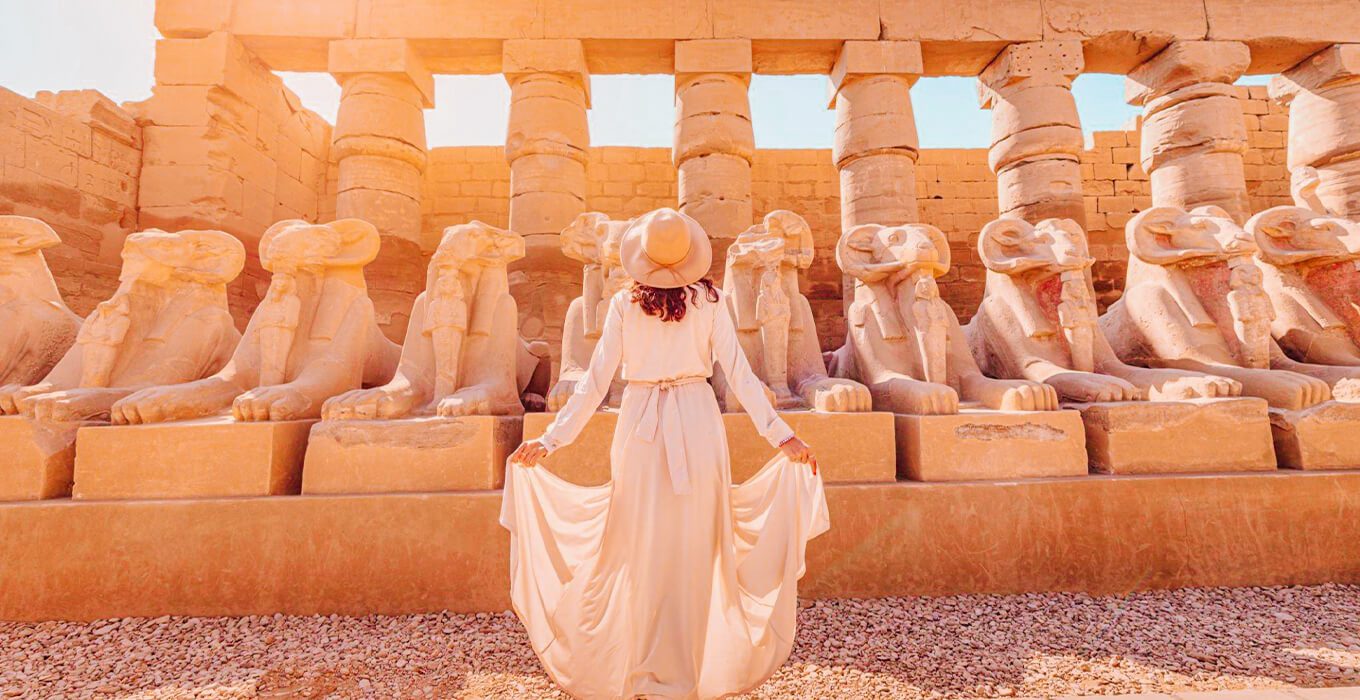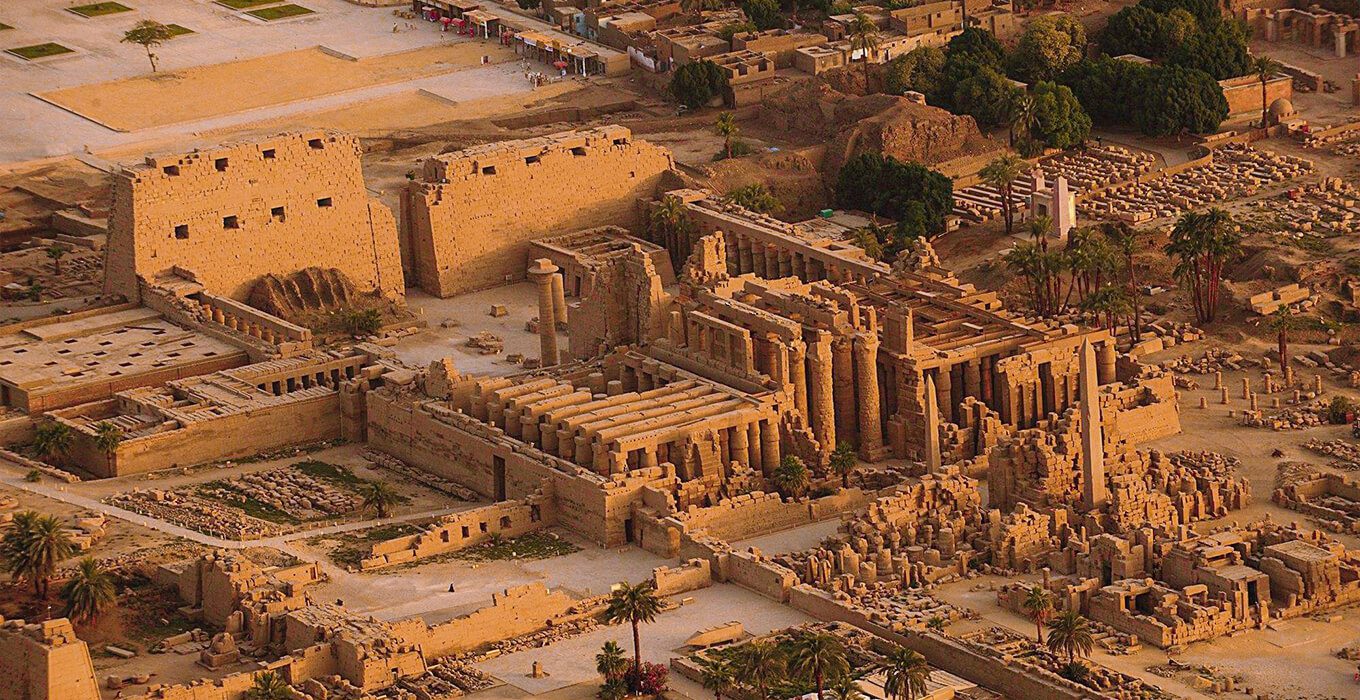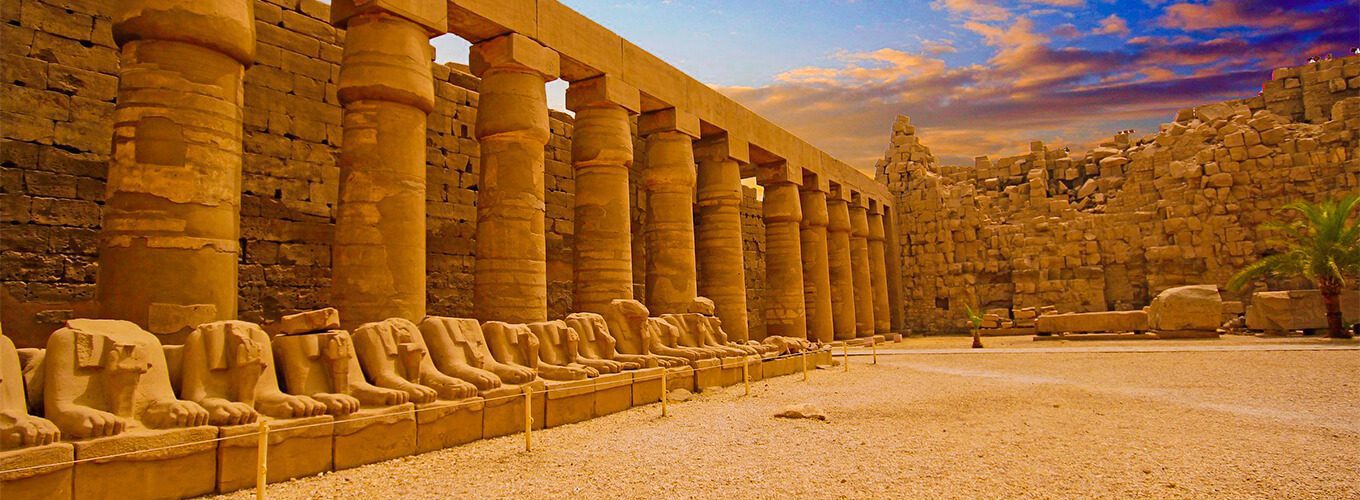Explore the wonders of Luxor’s iconic Karnak Temple Complex in Luxor City, a magnificent monument from the New Kingdom era. Dedicated to Amun, the supreme deity of heaven and fertility, this colossal temple is the largest divine sanctuary in ancient Egypt.
Nestled in southern Egypt, the Karnak Temple Complex is a sprawling religious marvel, showcasing meticulously arranged places of worship and towering structures. Each pharaoh etched their legacy across the Eleventh Dynasty and Greco-Roman rule by adding chapels, towers, and grand hypostyle halls to this monumental site.
Encompassing over 100 hectares, the temple’s construction spanned more than two millennia, a testament to the enduring dedication of countless artisans. A visit to the Karnak temples is a journey through more than 2,000 years of history, making it a UNESCO World Heritage Site and a true marvel of ancient Egypt.
Situated on the banks of the Nile within Luxor, the Karnak Temple is a vast complex of sacred structures dating back to the Pharaohs’ era. It is one of Egypt’s premier tourist attractions, captivating visitors with its massive gates, intricately adorned columns, towering obelisks, colossal statues, and an enchanting alley with hundreds of stone sphinxes.
This architectural masterpiece draws tourists from around the globe, seeking to marvel at the pearl of ancient Egyptian architecture. Karnak Temple ranks Egypt’s second-most popular tourist destination, closely behind the renowned Giza Pyramids.
In the annals of ancient Egyptian and Greek history, the Karnak Temple was pivotal as one of Egypt’s most significant and celebrated religious sites. The revered gods Amun, Mut, and Khonsu were primarily the driving forces behind its construction, which also had other religious and historical motivations. Join us in unraveling the mysteries and rich history embedded in the sacred grounds of Karnak Temple.
Combine the thrill of exploration with the luxury of relaxation on our Luxury Nile Cruises.The ultimate Egyptian adventure awaits.
Unraveling the Mystery: The Enigmatic Name of Karnak Temple
The origins of the name “Karnak Temple” are shrouded in secrecy, leaving enthusiasts and historians intrigued. Some speculate that the name has ancient Arabic roots, tracing it back to “al-Kharnaq,” meaning “the village that is guarded.” According to this theory, Karnak was perceived as a sacred place where rituals and sacrifices took place to the supreme god Amun.
Embarking on a private journey to Karnak is akin to stepping back into the Old Kingdom of Egypt. During ancient times, Egyptians flocked to this expansive temple complex for worship, while Thebes, now known as Luxor, served as the hub of governance. The sheer size of Karnak reflects its paramount importance during that era.
Beyond its role as a place of worship in the New Kingdom, Karnak was a hub of political power, serving as the pharaoh’s seat and the epicenter of government affairs. Over 1,500 years, Karnak witnessed the construction of temples, shrines, and distinctive architectural marvels unique to Egypt. This accumulation of history cements Karnak’s status as one of the most significant archaeological sites globally.
Consider the offerings laid before you. Egypt is the destination for those eager to delve into ancient Egyptian history, featuring iconic landmarks like the pyramids and the Sphinx. Unlock the secrets of Karnak Temple, where every stone holds a tale of worship, governance, and the enigmatic echoes of an ancient civilization.
American travelers, your adventure into antiquity starts with our Luxury Egypt Tours Packages from USA. Experience Egypt’s legendary sights in unrivaled luxury.


Unlocking the Significance of the Karnak Temple
In the heyday of the New Kingdom, when Thebes (modern-day Luxor) held the reins of power, the Karnak Temple Complex emerged as the epicenter of ancient religion. Its grand scale was a testament to its profound importance during this era.
Beyond its role as a sacred site, the Karnak Temple served a multifaceted purpose, functioning as a palace, administrative hub, and even a treasury for the pharaohs of the New Kingdom. Remarkably, it is believed to be the largest temple complex ever erected.
While reaching the zenith of its significance during the New Kingdom and the reigns of illustrious pharaohs like Hatshepsut, Thutmose III, Seti I, and Ramesses II, Karnak continued to evolve. Each of these pharaohs left an indelible mark on the complex, expanding its grandeur and importance. Even during the Greco-Roman era, the Ptolemies, Romans, and early Christians made notable contributions, further enriching the historical tapestry of Karnak.
You walk on layers of history that various civilizations have woven into the vast expanse of the Karnak Temple as you explore it, leaving an enduring legacy on this unmatched archaeological wonder.
Dive into the heart of Egypt’s majestic landscapes and rich history with our Luxury Egypt Tours and Holidays from UK. Your luxurious journey starts here.
The monumental structure of the Temple of Karnak
The structure was even more critical during the New Kingdom, when Hatshepsut, Thutmose III, Seti I, and Ramesses II were pharaohs. Each of these pharaohs helped build the complex in their own way. During the Greco-Roman period, the Ptolemies, Romans, and early Christians added growth to the structures, and each of these cultures left a significant imprint.
Karnak consists of three parts: the precinct of Amun, Mut, and Montu. It is smaller than any other significant site in Egypt due to the way it was constructed. The most famous parts of the Karnak complex are located in the precinct of Amun, including the Great Hall of Columns, one of the unique places in Egypt.
Breaking down the different parts that make up the complex is complicated, so we’ll let the tour guide take care of it. Instead, we suggest you take some time to look around this vast complex, admire its beauty, and imagine what it might have looked like 2,000 years ago.


Unveiling the Significance of the Karnak Temple Complex
Watch the sound and light show.
Immerse yourself in the captivating tale of Karnak Temple through the mesmerizing Sound and Light Show, a unique and enjoyable experience. Held in the evening against the backdrop of this historically rich complex, the show is considered one of Egypt’s most renowned attractions, showcasing the importance of the Karnak Temple.
This enchanting spectacle guides you through the temple’s passages, narrating the story of Egyptian history. As you traverse the temple, lights illuminate different sections, creating a special and unforgettable atmosphere. Complementing the experience, complimentary headphones, available before the show, enable you to listen to the narration in your preferred language.
Personalize your dream vacation with our Egypt Tailor Made Holidays. Start crafting your bespoke adventure today!
Fascinating Insights into Karnak Temple
- To the south of the Temple of Amun lies the sacred lake, whose waters are saline. At the lake’s edge, a grand granite scarab dedicated to the sun god Atum-Khepri in the form of a scarab stands prominently.
- For photographers seeking the perfect shot, the golden hour at five in the evening is optimal. Witness the stonework gleaming in the sunlight, casting majestic shadows on the intricately carved reliefs on the temple walls.
- Beyond the second tower lies the Hypostyle Hall, rightfully acclaimed as one of the world’s wonders. It spans an impressive 103 by 52 meters or over 5,000 square meters.
- Remarkably, Karnak is believed to be the birthplace of surgical instruments. Archaeologists unearthed forceps, scalpels, childbirth chairs, and containers with medicinal substances at the Kom Ombo temple within the Karnak complex.
- The temple grounds house over 420,000 sacred animals dedicated to Amun, with strict prohibitions preventing individuals of humble origin from entering.
- Despite the ravages of time, Karnak Temple, though plundered by armies and explorers, stands as one of the few majestic temple complexes today. The realms of the pharaohs may have faded, but Karnak’s enduring power transcends the ages, a testament to the everlasting allure of this ancient stone sanctuary.
Related articles:
- Top 17 Things To Do in Luxor: Luxor Wonder Landmarks
- Luxor Museum: A Journey to Explore the Ancient Artifacts
- Luxor Temple: Where History and Mythology Meet
- Egypt Temples: A Guide to the Country’s Most Iconic Temples
- What is the best trip to Egypt? A Guide to Choose Your Trip
- 14 Days Luxury Tour Cairo
